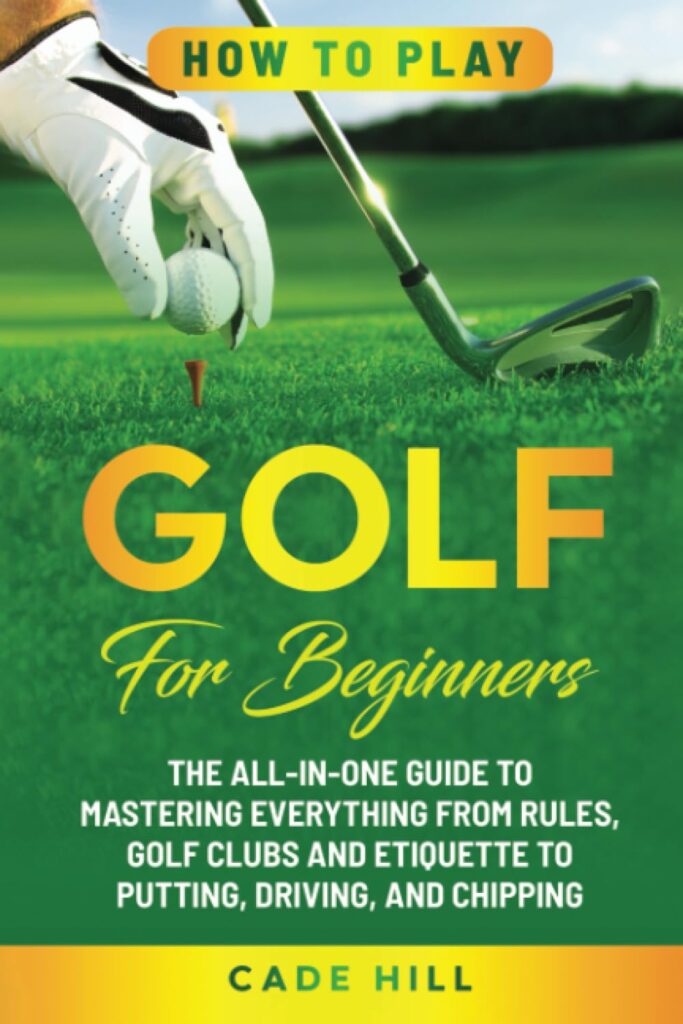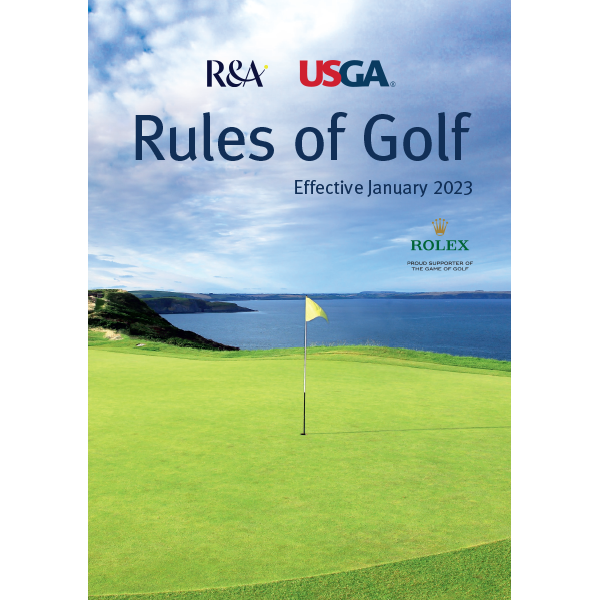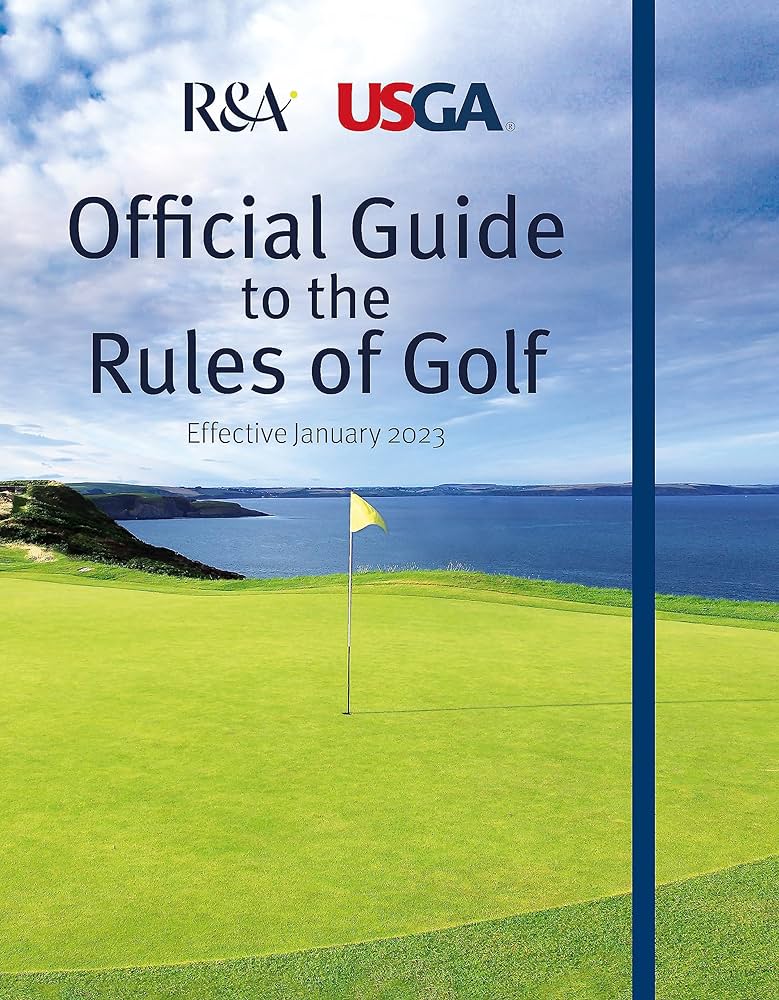The Rules of Golf book outlines regulations and procedures for playing the game. This official guide ensures fair play and standardizes golf worldwide.
Every golfer, from amateur enthusiasts to seasoned professionals, can understand and play by a common set of rules with the authoritative “Rules of Golf” book as their guide. Governed by The R&A and the United States Golf Association (USGA), this manual covers every aspect of the game, from the basic etiquettes to complex situations that may occur during play.
It is revised every four years to address the evolving nature of the game, ensuring the sport remains competitive and enjoyable for all. The book is not just a set of instructions; it’s an essential companion that helps maintain the integrity and spirit of golf, making it a must-have for anyone serious about understanding and respecting this time-honored sport.
Beside this, you can read my full article such as golf book for beginner, golf book for women, golf book for children even golf book for baby.These books are full of tips and secrets. You should also read articles about golf log book and golf biography books.
Teeing Off
Golf starts with a powerful swing from the tee box. This first stroke sets the game’s tone. Everyone follows rules to ensure fairness. Understanding the ‘Teeing Off’ process is key. Let’s dive into the ‘Starting the Game’ and ‘Tee Area Regulations’.
Starting The Game
Decide the playing order. Use a coin toss or golfer’s scores to choose. Each player tees off when their turn comes. Stick to the order throughout the round for consistency. On the next hole, the player with the best score goes first.
Tee Area Regulations
The tee area is special. Golfers must follow these rules:
- Place the ball between tee markers. It can be up to two club-lengths behind them.
- You cannot touch the ground with your club in front of the teeing area.
- If the ball falls off the tee, re-tee without penalty, as long as a stroke wasn’t made.
Playing outside the tee area means replaying the shot with a penalty.
| Do | Don’t |
|---|---|
| Stay within tee area boundaries. | Hit the ball in front of markers. |
| Keep the same playing order. | Play out of turn. |
| Re-tee without penalty if the ball was not stroked. | Incur penalties for teeing errors. |
Remember to respect these rules for a smooth teeing off experience. Learn more from the book below.

Credit: publications.randa.org
Stroke Play And Match Play
When grabbing your clubs for a round of golf, you’ll face a key choice: stroke play or match play. Each format has unique rules and strategies. Understanding these can give you an edge on the course.
Key Differences
Stroke play and match play are distinct game types. In stroke play, every shot counts towards a cumulative score. In match play, golfers compete hole by hole.
- Stroke Play: Total shots matter across the entire course.
- Match Play: Win individual holes to outscore opponents.
Scoring Systems
Different scoring methods shape the gameplay and strategies in stroke and match play.
Stroke Play:
| Hole Score | Total Impact |
|---|---|
| Bogey (+1) | Adds to overall score |
| Par (0) | Neutral effect |
| Birdie (-1) | Reduces total score |
Match Play:
- Win a hole, earn a point.
- Lose a hole, opponent earns a point.
- Tie a hole, no points awarded.
Scorecards look different in these formats. In stroke play, mark every stroke. In match play, tally points per hole.
The player with the lowest stroke total or the most points in match play wins the game.
Golf Etiquette

Understanding Golf Etiquette is as crucial as mastering the swing. Etiquette sets the tone for a respectful and enjoyable game. Dive into the dos and don’ts of golf behavior and course priorities with our guide.
Golf Etiquette book Has following:
Maintaining proper conduct on the golf course isn’t just about tradition; it’s about creating a pleasant environment for everyone involved. Let’s cover the essentials:
- Respect your peers: Wait for their shot, remain silent, and avoid distractions.
- Preserve the course: Repair divots, rake sand bunkers, and avoid damaging the greens.
- Dress appropriately: Follow the dress code of the course to show your respect for the game and the venue.
- Keep pace: Play at a good speed and be ready when it’s your turn.
- Be aware: Always ensure safety by being mindful of where others are standing.
| Situation | Priority |
|---|---|
| Furthest from the hole | Plays first |
| Lost ball | Allow following group to play through |
| Faster group | Yield to them if your group is slower |
| Teeing off | Honor system or player with the best score on the last hole |
Out Of Bounds And Hazards
Golf is a game of precision and rules, carefully guiding players through courses filled with challenges. One set of rules that often come into play pertains to out of bounds areas and various hazards. Recognizing these tricky areas and understanding how to navigate them is vital in maintaining a solid scorecard and respecting the integrity of the sport. Let’s explore the specifics and procedures every golfer should follow.
Identifying Penalty Areas
Penalty areas are defined regions on the course where a ball might be lost or unable to be played. Recognizing these zones is critical. Red and yellow markers are commonly used to indicate penalty areas. A red marker signifies a lateral hazard, which grants more relief options, while a yellow marker denotes a regular hazard.
- Red Penalty Areas: Often run parallel to the course.
- Yellow Penalty Areas: Found around water bodies like lakes or ponds.
Not every water feature is marked, so consult the official course map. Natural boundaries are also considered, such as sea borders.
Procedures For Relief
When a ball lands within a penalty area, specific procedures allow for relief. Players must follow these steps to ensure fair play and avoid penalty strokes.
- Determine where the ball last crossed into the penalty area.
- Choose to either play the ball as it lies without penalty or take relief.
- If taking relief, assess whether it is a red or yellow penalty area to determine options.
| Penalty Area Type | Relief Options |
|---|---|
| Red | Lateral relief or back-on-the-line relief. |
| Yellow | Back-on-the-line relief or stroke-and-distance relief. |
For each relief action, a one-stroke penalty applies. Always drop the ball from knee height when taking relief. Checking with fellow players or a caddie can help avoid mistakes.
The Putting Green
Every golf enthusiast knows the thrill of a potential birdie as the ball dances along the finely-trimmed turf towards the hole. Here, precision and knowledge of the green’s subtle rules are just as important as your putt’s strength and aim. Knowing the intricacies of the green can make the difference between a round to remember and a golf tale of woe.
Ball Markings And Movement
On the green, the ball’s identity and its movement are critical. Mark your ball correctly to save yourself from penalties and to keep the play fair.
- Mark your golf ball before lifting it to ensure it gets placed on the exact spot later.
- No penalty if the ball moves after being marked, provided the movement is accidental.
- Remember, play it as it lies. Incorrectly replacing a moved ball could cost you strokes.
Flagstick Rules
Rules about the flagstick have evolved. Stay ahead of the game with the latest directives.
| Flagstick Situation | Rule |
|---|---|
| Before making a stroke on the green | Leave the flagstick in or take it out. |
| Your ball hits the flagstick in the hole | No penalty unless you deliberately positioned it to stop or deflect your ball. |
| Attended flagstick | Have it removed beforehand, or ensure it’s not moved during the stroke to avoid penalties. |
These changes aim to improve the pace of play and make the putting experience smoother. Remember that knowing the rules is key to a strategic game on the putting green. So, keep these points in mind, focus on your putt, and enjoy the game!
Lost Ball And Provisional Ball
Every golfer knows the frustration of a lost ball. But, it’s crucial to understand the official rules. They guide what a player should do if their ball goes missing or might be out of play. The Rules of Golf Book sets out clear instructions for dealing with a Lost Ball and Provisional Ball. Let’s delve into the specifics and make sure your game stays on par!
Search Time Limit
The clock ticks when you can’t find your ball. Golf rules give you a set time to locate it. Three minutes – that’s all you’ve got. Start timing from when you or your caddie start searching. Not finding the ball within the time limit? Consider it lost.
Playing A Provisional
Sometimes you suspect your ball may be lost or out of bounds. That’s when playing a provisional ball is wise. This backup ball keeps the game moving. Announce your intention to hit a provisional before you play it. Remember to make it clear to your fellow players. This way, everyone knows it’s a provisional shot.
Understanding these rules can avoid penalty strokes and keep your pace of play. Always carry an extra ball, and know these rules inside and out. Your scorecard and playing partners will thank you!
| Quick Recap: Lost and Provisional Ball Rules | |
|---|---|
| Lost Ball | Search for 3 minutes max, then it’s lost. |
| Provisional Ball | Announce intention, play before 3-min search ends. |
- How to Play a Provisional Ball:
- Declare it to fellow players.
- Play the provisional ball before going forward to search.
- Continue with provisional if original ball is lost or out of bounds.
- When a Ball is Lost:
- After 3-minute search without success.
- When not found or identified as yours by anyone else.
Obstructions And Relief
On the green, it’s not just about swings and putts. Knowing Obstructions and Relief is key. This part of the Rules of Golf Book keeps the game fair. Let’s dive into what counts as an obstruction and how to get relief. You’ll play confidently, knowing the ins and outs.
Movable And Immovable
Firstly, obstructions come in two types: movable and immovable. Movable ones are items that can be easily moved. Think about bottles, cans, or rakes. They shouldn’t disrupt your play. If they do, you can move them away.
Immovable ones are trickier. These are parts of the course like buildings or sprinkler heads. They’re firmly fixed and not meant to move. If they’re in your way, special rules apply.
Relief Procedures
Finding your ball in a tricky spot can be a hassle. But don’t worry, there are relief procedures.
If a movable obstruction blocks your ball, simply remove it. But be careful! Your ball must stay in its spot.
With immovable objects, it’s different. You might get free relief or penalty relief. This depends on where your ball lies.
Check these steps for relief:
- Find the nearest point of complete relief. This is where your ball would lie without the obstruction.
- Measure one club-length from that spot. This area is your relief area.
- Drop your ball in the relief area. Your ball must stay inside this area when it lands.
Remember, the relief procedure is there to keep the game fair. But it doesn’t guarantee an easier shot!
You can have a look the following book.

Credit: www.amazon.com
Club Rules And Ball Specifications
Understanding the Rules of Golf is crucial for both novice and experienced players. The Club Rules and Ball Specifications section focuses on the equipment players use. This integral part of the game ensures fair play and upholds the integrity of the sport. Knowledge of these rules helps players avoid penalties and ensures consistency in competition.
Allowed Clubs
Golfers must select clubs that conform to strict guidelines. Here is what to remember:
- Number of Clubs: Carry no more than 14 clubs in your bag.
- Conforming Clubs: Each club must meet the shape, design, and dimensions set by the rules.
- Damage: If a club gets damaged during the round, you cannot replace it unless it is unfit for play.
Standards For Golf Balls
The right golf ball can impact your game. Notice the following about golf balls:
| Characteristic | Specification |
|---|---|
| Size | Not smaller than 1.680 inches in diameter |
| Weight | No more than 1.620 ounces |
| Symmetry | The ball must be symmetrical in flight |
| Velocity and Distance | Exact values set by the authorities |
Ensure your equipment adheres to these rules for a game that aligns with the true spirit of golf.
Breaches And Penalties
Golf is a game of precision and rules, where every action aligns with a specific regulation. In this elegant and disciplined sport, knowing the ‘Breaches and Penalties’ laid out in the Rules of Golf Book is crucial for every player. These rules ensure fair play and maintain the integrity of the game. Players must be aware of the penalties for various infringements to avoid unnecessary strokes on their scorecard.
Types Of Penalties
Penalties in golf come in various forms, depending on the severity of the breach. Let’s dive into the common types:
- Stroke Penalty: Added for minor breaches like an incorrect drop.
- General Penalty: Typically a loss of hole in match play or two strokes in stroke play.
- Disqualification: For serious breaches, such as signing for a wrong score.
Knowing what action leads to which penalty helps players avoid costly mistakes.
Procedure For Rulings
When a breach occurs, it’s important to know the procedure for rulings:
- Identify the Breach: Recognize the rule that’s been broken.
- Declare the Breach: Inform your fellow players or a referee.
- Apply the Penalty: Add the appropriate stroke or strokes.
- Continue Play: Proceed with the game without delay.
Correctly following these steps ensures the game remains fair and enjoyable for all participants.

Credit: www.usgapublications.com
Frequently Asked Questions On Rules Of Golf Book
What Is Rule 27 In Golf?
Rule 27 in golf addresses the procedures for playing a ball that has been lost or is out-of-bounds. It provides players with options such as stroke-and-distance relief.
What Is Rule 13 In Golf?
Rule 13 in golf specifies procedures for playing the ball as it lies, using the club’s striking face, and the player’s obligations when the ball is in play.
How Many Golf Rules Are There?
There are 24 rules in golf, as stated by the official rule book from the R&A and the United States Golf Association (USGA).
Conclusion
Navigating the complexities of golf is made smoother with a firm grasp of its rules. By digesting the contents of the Rules of Golf Book, players can confidently tackle the greens. Stay fair, stay informed, and enjoy the game as it’s meant to be played.
Keep this guide handy; your swing depends on it.
If you’re looking for more than laughs and want to improve your game, consider checking out instructional golf books and golf humorous book as well.
You enjoyed this post? You can read my following articles..
150 Golf Courses Book Review Unveiling the Top Greens
Kelley Blue Book Golf Carts Valuations, Tips, and Market Insights
What is Green Book in Golf Your Ultimate Course Guide?
World Best Golf Courses Coffee Table Book Swing into Elegance
Golf Car Blue Book Values: Drive Your Best Deal!

